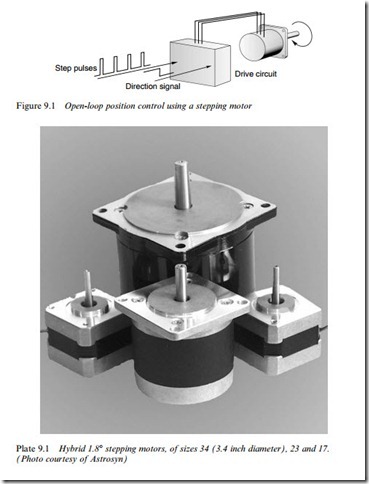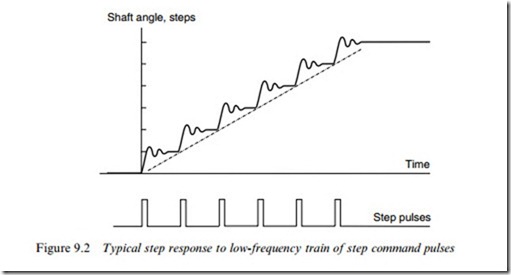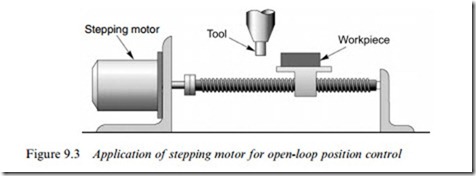INTRODUCTION
Stepping motors are attractive because they can be controlled directly by computers or microcontrollers. Their unique feature is that the output shaft rotates in a series of discrete angular intervals, or steps, one step being taken each time a command pulse is received. When a deWnite number of pulses has been supplied, the shaft will have turned through a known angle, and this makes the motor ideally suited for open-loop position control.
The idea of a shaft progressing in a series of steps might conjure up visions of a ponderous device laboriously indexing until the target number of steps has been reached, but this would be quite wrong. Each step is completed very quickly, usually in a few milliseconds; and when a large number of steps is called for the step command pulses can be delivered rapidly, sometimes as fast as several thousand steps per second. At these high stepping rates the shaft rotation becomes smooth, and the behaviour resembles that of an ordinary motor. Typical applications include disc head drives, and small numerically controlled machine tool slides, where the motor would drive a lead screw; and print feeds, where the motor might drive directly, or via a belt.
Most stepping motors look very much like conventional motors, and as a general guide we can assume that the torque and power of a stepping motor will be similar to the torque and power of a conventional totally enclosed motor of the same dimensions and speed range. Step angles are mostly in the range 1.88–908, with torques ranging from 1 mNm (in a tiny wristwatch motor of 3 mm diameter) up to perhaps 40 Nm in a motor of 15 cm diameter suitable for a machine tool application where speeds of 500 rev/min might be called for. The majority of applications fall between these limits, and use motors that can comfortably be held in the hand.
Open-loop position control
A basic stepping motor system is shown in Figure 9.1. The drive con- tains the electronic switching circuits, which supply the motor, and is discussed later. The output is the angular position of the motor shaft, while the input consists of two low-power digital signals. Every time a
pulse occurs on the step input line, the motor takes one step, the shaft remaining at its new position until the next step pulse is supplied. The state of the direction line (‘high’ or ‘low’) determines whether the motor steps clockwise or anticlockwise. A given number of step pulses will therefore cause the output shaft to rotate through a deWnite angle.
This one to one correspondence between pulses and steps is the great attraction of the stepping motor: it provides position control, because the output is the angular position of the output shaft. It is a digital system, because the total angle turned through is determined by the number of pulses supplied; and it is open-loop because no feedback need be taken from the output shaft.
Generation of step pulses and motor response
The step pulses may be produced by an oscillator circuit, which itself is controlled by an analogue voltage, digital controller or microprocessor. When a given number of steps is to be taken, the oscillator pulses are gated to the drive and the pulses are counted, until the required number of steps is reached, when the oscillator is gated oV. This is illustrated in Figure 9.2, for a six-step sequence. There are six-step command pulses, equally spaced in time, and the motor takes one step following each pulse.
Three important general features can be identiWed with reference to Figure 9.2. Firstly, although the total angle turned through (six steps) is governed only by the number of pulses, the average speed of the shaft (which is shown by the slope of the broken line in Figure 9.2) depends on the oscillator frequency. The higher the frequency, the shorter the time taken to complete the six steps.
Secondly, the stepping action is not perfect. The rotor takes a Wnite time to move from one position to the other, and then overshoots and oscillates before Wnally coming to rest at the new position. Overall single-step times vary with motor size, step angle and the nature of the load, but are commonly within the range 5–100 ms. This is often fast enough not to be seen by the unwary newcomer, though individual steps can usually be heard; small motors ‘tick’ when they step, and larger ones make a satisfying ‘click’ or ‘clunk’.
Thirdly, in order to be sure of the absolute position at the end of a stepping sequence, we must know the absolute position at the beginning. This is because a stepping motor is an incremental device. As long as it is not abused, it will always take one step when a drive pulse is supplied, but in order to keep track of absolute position simply by counting the number of drive pulses (and this is after all the main virtue of the system) we must always start the count from a known datum position. Normally the step counter will be ‘zeroed’ with the motor shaft at the datum position, and will then count up for clockwise direction, and down for anticlockwise rotation. Provided no steps are lost (see later) the number in the step counter will then always indicate the absolute position.
High-speed running and ramping
The discussion so far has been restricted to operation when the step command pulses are supplied at a constant rate, and with suYciently long intervals between the pulses to allow the rotor to come to rest between steps. Very large numbers of small stepping motors in watches and clocks do operate continuously in this way, stepping perhaps once every second, but most commercial and industrial applications call for a more exacting and varied performance.
To illustrate the variety of operations which might be involved, and to introduce high-speed running, we can look brieXy at a typical industrial application. A stepping motor-driven table feed on a numerically con- trolled milling machine nicely illustrates both of the key operational features discussed earlier. These are the ability to control position (by supplying the desired number of steps) and velocity (by controlling the stepping rate).
The arrangement is shown diagrammatically in Figure 9.3. The motor turns a leadscrew connected to the worktable, so that each motor step causes a precise incremental movement of the workpiece relative to the cutting tool. By making the increment small enough, the fact that the motion is discrete rather than continuous will not cause any diYculties in the machining process. We will assume that we have selected the step
angle, the pitch of the leadscrew, and any necessary gearing so as to give a table movement of 0.01 mm per motor step. We will also assume that the necessary step command pulses will be generated by a digital con- troller or computer, programmed to supply the right number of pulses, at the right speed for the work in hand.
If the machine is a general-purpose one, many diVerent operations will be required. When taking heavy cuts, or working with hard material, the work will have to be oVered to the cutting tool slowly, at say, 0.02 mm/s. The stepping rate will then have to be set to 2 steps/s. If we wish to mill out a slot 1-cm long, we will therefore programme the controller to put out 1000 steps, at a uniform rate of 2 steps per second, and then stop. On the other hand, the cutting speed in softer material could be much higher, with stepping rates in the range 10–100 steps per second being in order. At the completion of a cut, it will be necessary to traverse the work back to its original position, before starting another cut. This operation needs to be done as quickly as possible, to minimise unproductive time, and a stepping rate of perhaps 2000 steps per second (or even higher), may be called for.
It was mentioned earlier that a single step (from rest) takes upwards of several milliseconds. It should therefore be clear that if the motor is to run at 2000 steps per second (i.e. 0.5 ms/step), it cannot possibly come to rest between successive steps, as it does at low stepping rates. Instead, we Wnd in practice that at these high stepping rates, the rotor velocity becomes quite smooth, with hardly any outward hint of its stepwise origins. Nevertheless, the vital one-to-one correspondence between step command pulses and steps taken by the motor is maintained through- out, and the open-loop position control feature is preserved. This extra- ordinary ability to operate at very high stepping rates (up to 20 000 steps per second in some motors), and yet to remain fully in synchronism with the command pulses, is the most striking feature of stepping motor systems.
Operation at high speeds is referred to as ‘slewing’. The transition from single stepping (as shown in Figure 9.2) to high-speed slewing is a gradual one and is indicated by the sketches in Figure 9.4. Roughly speaking, the motor will ‘slew’ if its stepping rate is above the frequency of its single-step oscillations. When motors are in the slewing range, they generally emit an audible whine, with a fundamental frequency equal to the stepping rate.
It will come as no surprise to learn that a motor cannot be started from rest and expected to ‘lock on’ directly to a train of command pulses, at say, 2000 steps per second, which is well into the slewing range. Instead, it has to be started at a more modest stepping rate, before being accelerated (or ‘ramped’) up to speed: this is discussed more fully later in Section 9.5. In undemanding applications, the ramp- ing can be done slowly, and spread over a large number of steps; but if the high stepping rate has to be reached quickly, the timings of individ- ual step pulses must be very precise.
We may wonder what will happen if the stepping rate is increased too quickly. The answer is simply that the motor will not be able to remain ‘in step’ and will stall. The step command pulses will still be delivered, and the step counter will be accumulating what it believes are motor steps, but, by then, the system will have failed completely. A similar failure mode will occur if, when the motor is slewing, the train of step pulse is suddenly stopped, instead of being progressively slowed. The stored kinetic energy of the motor (and load) will cause it to overrun, so that the number of motor steps will be greater than the number of command pulses. Failures of this sort are prevented by the use of closed-loop control, as discussed later.
Finally, it is worth mentioning that stepping motors are designed to operate for long periods with their rotor held in a Wxed (step) position, and with rated current in the winding (or windings). We can therefore anticipate that stalling is generally not a problem for a step- ping motor, whereas for most other types of motor, stalling results in a collapse of back e.m.f. and a very high current which can rapidly lead to burnout.



